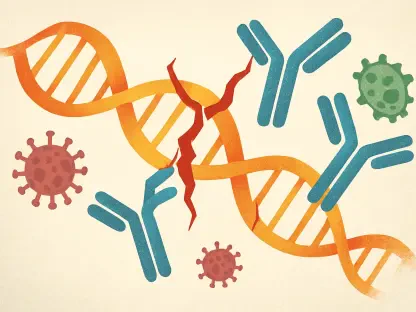Cancer research has taken a remarkable leap forward with a recent study published in Nature Communications by Cao et al., shedding light on a previously unknown molecular mechanism that fuels tumor growth and opens new avenues for therapy. This groundbreaking work reveals a unique interaction between a circular RNA (circRNA) molecule, known as circMAN1A2(2,3,4,5), and the messenger RNA (mRNA) of centromere protein B (CENPB), a critical player in cell division. This partnership significantly accelerates cell proliferation, a defining characteristic of cancer progression in various types, including lung, breast, and colorectal cancers. Unlike traditional views that relegated RNAs to passive roles in cellular processes, this discovery positions them as active regulators with profound implications for how tumors develop. The findings not only challenge long-held assumptions about RNA function but also ignite hope for innovative therapies that could target this specific interaction. As the scientific community buzzes with excitement, this molecular link offers a fresh perspective on tackling one of the most pressing health challenges of the era.
Unraveling a Molecular Partnership
The core of this research lies in the intricate relationship between circMAN1A2(2,3,4,5), a type of circRNA distinguished by its stable, closed-loop structure, and CENPB mRNA. CENPB is a protein essential for assembling centromeres, the structures that guide proper chromosome separation during cell division. When circMAN1A2 binds directly to CENPB mRNA, it shields the mRNA from degradation and enhances its translation into protein, resulting in elevated CENPB levels. In the context of cancer, this overproduction becomes a catalyst for rapid, uncontrolled cell division—a fundamental driver of tumor growth. The study meticulously details how this interaction operates at a molecular level, providing a clearer understanding of the mechanisms that cancer cells exploit to sustain their aggressive behavior. This finding marks a significant departure from earlier assumptions about RNA, highlighting its capacity to actively influence critical cellular functions rather than merely serving as a conduit for genetic information.
Beyond the basic mechanics of this binding, the precision of the interaction stands out as a key revelation. Researchers have mapped the exact nucleotide sequences where circMAN1A2 connects with CENPB mRNA, uncovering a highly specific and deliberate process. This isn’t a random occurrence but a calculated mechanism that cancer cells leverage to maintain their relentless proliferation. Such detailed insight into the binding interface offers a promising foundation for developing targeted interventions. By understanding the exact points of contact, scientists can explore ways to disrupt this connection, potentially stalling cancer progression at its molecular roots. The implications of this precision extend beyond academic interest, pointing toward practical applications in drug design that could transform how certain cancers are treated, shifting the focus to therapies that address the specific vulnerabilities of tumor cells without broadly impacting healthy tissues.
Impact on Tumor Development
Delving deeper into the consequences of the circMAN1A2-CENPB interaction, it becomes evident that this partnership plays a pivotal role in promoting genomic instability, a hallmark of cancer. Excessive CENPB, driven by the stabilizing effect of circMAN1A2, can disrupt the delicate balance of chromosome segregation during mitosis, leading to errors that accumulate over time. These mistakes often result in more aggressive tumor behavior, as cells with damaged or unevenly distributed genetic material gain a survival edge. The research demonstrates that this RNA-driven mechanism directly contributes to the chaotic growth patterns observed in cancers, making it a critical factor in disease progression. This insight shifts the perspective on how molecular interactions at the RNA level can have cascading effects on the broader behavior of malignant cells, emphasizing the need to address such mechanisms in treatment strategies.
Further exploration in the study reveals that manipulating circMAN1A2 levels has a direct impact on cancer cell dynamics. When levels of this circRNA are reduced, CENPB expression drops, significantly slowing cell division and curbing tumor growth. Conversely, increasing circMAN1A2 amplifies CENPB production, exacerbating the tumorigenic traits of cancer cells. These experimental outcomes underscore the interaction’s role as a central driver of malignancy, rather than a mere bystander in the process. Such findings highlight the potential of targeting this specific RNA link as a means to control cancer progression, offering a glimpse into how fine-tuned molecular adjustments could yield substantial therapeutic benefits. The ability to influence tumor behavior through RNA modulation represents a compelling avenue for future research and clinical application, pushing the boundaries of conventional cancer management.
Potential for Innovative Therapies
One of the most exciting aspects of this discovery is its promise for developing novel cancer treatments. Given the highly specific nature of the binding site between circMAN1A2 and CENPB mRNA, there is a clear opportunity to design targeted therapies, such as antisense oligonucleotides or small-molecule inhibitors, to break this interaction. Such approaches could effectively halt cancer cell proliferation while minimizing the collateral damage often seen with broader treatments like chemotherapy or radiation. The structural stability of circRNAs, combined with their tendency to exhibit tissue-specific or cell-type-specific expression patterns, further enhances their appeal as therapeutic targets. This specificity could reduce the risk of off-target effects, a common challenge in current cancer therapies, paving the way for more precise and less toxic interventions that prioritize patient well-being.
Additionally, the therapeutic potential extends to the broader landscape of personalized medicine. By focusing on the circMAN1A2-CENPB axis, researchers could tailor treatments to individual patients based on the molecular profiles of their tumors. This aligns with the growing trend toward precision oncology, where therapies are customized to address the unique characteristics of a patient’s cancer. The study’s findings suggest that disrupting this RNA interaction could offer a selective advantage, impacting malignant cells while sparing healthy ones. As drug development pipelines begin to incorporate these insights, the hope is to create solutions that not only slow tumor growth but also improve quality of life for those affected. The path to clinical application may still require extensive testing, but the groundwork laid by this research provides a robust starting point for transforming how certain cancers are approached and managed in medical practice.
Redefining RNA’s Role in Biology
This study also signals a broader paradigm shift in the understanding of RNA’s function within cells. Historically viewed as a simple intermediary between DNA and protein synthesis, RNA—particularly circRNAs—is now recognized as a dynamic regulator capable of influencing gene expression through direct interactions. The circMAN1A2-CENPB connection serves as a prime example of how noncoding RNAs can play active roles in critical cellular processes, challenging outdated notions of their passive nature. This revelation urges the scientific community to re-evaluate the significance of RNA in both healthy and diseased states, pushing for a deeper exploration of other potential circRNA-mRNA partnerships that might govern various biological functions. The implications of this shift extend far beyond cancer, suggesting that RNA could hold keys to understanding and addressing a wide array of conditions.
Moreover, the research calls attention to the need for comprehensive profiling of circRNA interactions across different contexts. The circMAN1A2-CENPB axis may represent just one piece of a much larger regulatory network, hinting at countless other RNA-driven mechanisms waiting to be uncovered. This perspective encourages a more integrated approach to molecular biology, where noncoding RNAs are prioritized in research and therapeutic development. As scientists begin to map these intricate connections, the potential to unlock new insights into cellular behavior grows exponentially. The study acts as a catalyst for this expanded focus, inspiring initiatives that could redefine the boundaries of medical science. By positioning RNA as a central player in gene regulation, it opens doors to innovative strategies that could reshape the future of disease prevention and treatment across multiple fields.
Exploring New Horizons in Research
While the study provides substantial answers, it also uncovers fresh questions that demand further investigation. For instance, the behavior of circMAN1A2 in different cellular compartments, such as the nucleus and cytoplasm, remains poorly understood. How does its localization affect its regulatory role, and what additional factors might influence this process? These uncertainties highlight the complexity of RNA interactions and the need for continued exploration to fully grasp their implications. Addressing such gaps could reveal even more about how cancer cells co-opt these mechanisms for their advantage, offering new angles for therapeutic intervention. The research sets a compelling agenda for future studies, emphasizing the importance of delving deeper into the spatial and contextual dynamics of circRNAs within the cellular environment.
Equally intriguing is the possibility of other molecules interacting within or alongside the circMAN1A2-CENPB regulatory loop. Are there additional RNAs, proteins, or cellular components that modulate this relationship, and if so, how do they contribute to cancer progression? Unraveling these potential connections could provide a more holistic view of the molecular landscape driving tumorigenesis. The study’s findings serve as a springboard for broader investigations, encouraging researchers to pursue comprehensive analyses of RNA networks in various disease states. As these efforts unfold over the coming years, the hope is to build on this foundational work, uncovering strategies that could ultimately disrupt the intricate mechanisms cancer cells rely on. The journey to fully understand and leverage this interaction is just beginning, promising exciting developments on the horizon of cancer research.









